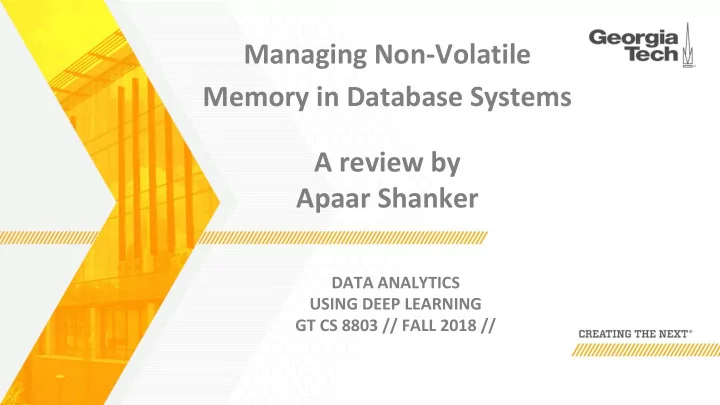

Managing Non-Volatile Memory in Database Systems A review by Apaar Shanker DATA ANALYTICS USING DEEP LEARNING GT CS 8803 // FALL 2018 //
Paper under review Managing Non-Volatile Memory in Database System S Authors: Alexander van Renen 1 , ViKtor Leis, Alfons Kemper 1 , Thomas Neumann 1 , Takushi Hashida 2 , Kazuichi Oe 2 , Yoshiyasu Doi 2 , Lilan Harada 2 , Mitsuru Sato 2 1 Technische Universität München, 2 Fujitsu Laboratories Publication: SIGMOD ‘18 doi:https://doi.org/10.1145/3183713.3196897 2 GT 8803 // Fall 2018
Salient Aspects of the Computer Memory Hierarchy NVM sits here https://en.wikipedia.org/wiki/Memory_hierarchy DOI: 10.1109/ASPDAC.2014.6742851, Fujita et al. 2014 3 GT 8803 // Fall 2018
Objective of the Paper This paper evaluates the current art and demonstrate a new approach for integrating NVM into the storage layer of database systems. 4 GT 8803 // Fall 2018
Non Volatile Memory Based Architectures B.M : Buffer Manager ref 1.) Alexander Van Renen et al. 2018 5 GT 8803 // Fall 2018
NVM Direct ❖ NVM Direct systems were investigated by Arulraj et al. ❖ Levarages byte addressability of NVM ❖ Features ➢ The design keeps all data in NVM ➢ DRAM is only used for temporary data and to keep a reference to NVM data ❖ Advantages ➢ minimalist log (containing only in-flight operations) ensures recovery is very efficient ➢ read operations are very simple because a tuple can be directly requested from the NVM. ❖ Downsides ➢ Higher latency of NVM compared to DRAM leads to difficulties in achieving a very high transaction throughputs ➢ Doing I/O on NVM directly wears out limited NVM endurance, leading to hardware failures ➢ Difficulty in programming database engines for NVM as any modification to is potentially persisted, and can lead to concurrency related problems. 6 GT 8803 // Fall 2018
Basic NVM Buffer Manager ❖ Kimura et al. proposed using a database managed DRAM as a cache in front of NVM ❖ Similar to the commonly used notion of a buffer manager between a volatile memory (RAM) and SSD ❖ Features ➢ All pages stores on the persistent layer (NVM) ➢ DRAM acts as a software managed buffer/cache layer. ➢ Transactions operate by accessing pages after loading them onto the buffer pool in DRAM ❖ Advantages ➢ DRAM comparable latency for accessing data in the buffer pool ➢ limits read/ write operation on NVM increasing hardware endurance ❖ Downsides ➢ accessible a tuple not present in the buffered pages, requires loading an entire page onto DRA, failing to leverage byte addressability ➢ System is optimized for workloads fitting into DRAM only - and does not scale to workloads on larger datasets which require accessing NVM resident data frequently as well. 7 GT 8803 // Fall 2018
Key Techniques in Current Approach ❖ Cache-Line-Grained Pages ❖ Mini Pages ❖ Pointer Swizzling 8 GT 8803 // Fall 2018
Cache-Line-Grained Pages ❖ Low nvm latency allows extraction of specific cache-lines rather than entire pages. ❖ Allows targeted extraction of “hot” data objects from otherwise cold page. ❖ Buffer manager allocates a page in DRAM without loading data from NVM ❖ Upon specific transaction request - buffer manager retrieves corresponding cache lines of the page. ❖ Drawbacks ➢ cache-line-grained access is more difficult to program compared to more traditional page-based approach. ❖ A hybrid approach is adopted where only specific operations such as insert, look-up, delete; that get most benefit from cache-line-grained access are implemented as such. 9 GT 8803 // Fall 2018
Mini Pages ❖ Allocating space for a full page, even when only few tuples are required, wastes valuable DRAM space ❖ Solution: A mini page that can store upto 16 cache lines ❖ An additional “slots” array stores the line id for an item in the original page ❖ In order to resolve the issue of offset, following function prototype is used. When a mini page does not have enough memory to serve a request, it is promoted to a full page. 10 GT 8803 // Fall 2018
Pointer Swizzling 11 GT 8803 // Fall 2018
Design Outline ❖ A 3-tier buffer management is implemented, which incorporates ssd as well, apart from DRAM and NVM. ❖ Addition of SSD - while not improving latency is important for management of large datasets. ❖ In current set-up the very cold data is stored in SSD. ❖ Initially, all new-pages start on SSD. On transaction request page is first directly loaded to DRAM and then relegated to NVM or SSD based on decisions. ➢ DRAM eviction ➢ NVM admission ➢ NVM eviction ■ clock algorithm ■ 12 GT 8803 // Fall 2018
Performance Evaluation ❖ ❖ YCSB is a key-value store benchmark framework TPC-C is considered the industry standard for ❖ Only point look up operations considered benchmarking transactional database systems. ❖ It is an insert-heavy workload that emulates a wholesale supplier. 13 GT 8803 // Fall 2018
Performance Evaluation across Architectures 14 GT 8803 // Fall 2018
Evaluation w.r.t NVM hardware characteristics 15 GT 8803 // Fall 2018
Comments ❖ Pointer swizzling could compromise data integrity through malicious or unwitting actors ❖ OS level optimizations not considered. ❖ Tradeoff between performance improvement and usability? - are these only one time programmer costs? ❖ What are the other metrics for performance other than throughput? Any economic metrics out there? 16 GT 8803 // Fall 2018
References [1] van Renen A, Leis V et al (2018) Managing non-volatile memory in database systems. SIGMOD ’18, pp 1541–1555 [2] Götze P, van Renen A (2018) Data management on non-volatile memory: A perspective, Datenbank Spektrum (2018) 18:171–182 17 GT 8803 // Fall 2018
Recommend
More recommend